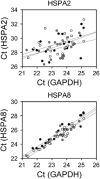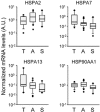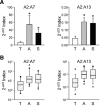Quantitative analyses of postmortem heat shock protein mRNA profiles in the occipital lobes of human cerebral cortices: implications in cause of death
- PMID: 23135635
- PMCID: PMC3887795
- DOI: 10.1007/s10059-012-0214-z
Quantitative analyses of postmortem heat shock protein mRNA profiles in the occipital lobes of human cerebral cortices: implications in cause of death
Abstract
Quantitative RNA analyses of autopsy materials to diagnose the cause and mechanism of death are challenging tasks in the field of forensic molecular pathology. Alterations in mRNA profiles can be induced by cellular stress responses during supravital reactions as well as by lethal insults at the time of death. Here, we demonstrate that several gene transcripts encoding heat shock proteins (HSPs), a gene family primarily responsible for cellular stress responses, can be differentially expressed in the occipital region of postmortem human cerebral cortices with regard to the cause of death. HSPA2 mRNA levels were higher in subjects who died due to mechanical asphyxiation (ASP), compared with those who died by traumatic injury (TI). By contrast, HSPA7 and A13 gene transcripts were much higher in the TI group than in the ASP and sudden cardiac death (SCD) groups. More importantly, relative abundances between such HSP mRNA species exhibit a stronger correlation to, and thus provide more discriminative information on, the death process than does routine normalization to a housekeeping gene. Therefore, the present study proposes alterations in HSP mRNA composition in the occipital lobe as potential forensic biological markers, which may implicate the cause and process of death.
Figures






Similar articles
-
Postmortem mRNA expression patterns in left ventricular myocardial tissues and their implications for forensic diagnosis of sudden cardiac death.Mol Cells. 2014 Mar;37(3):241-7. doi: 10.14348/molcells.2014.2344. Epub 2014 Mar 19. Mol Cells. 2014. PMID: 24642708 Free PMC article.
-
Forensic molecular pathology of violent deaths.Forensic Sci Int. 2010 Dec 15;203(1-3):83-92. doi: 10.1016/j.forsciint.2010.07.024. Epub 2010 Aug 16. Forensic Sci Int. 2010. PMID: 20719442 Review.
-
Postmortem quantitative mRNA analyses of death investigation in forensic pathology: an overview and prospects.Leg Med (Tokyo). 2009 Apr;11 Suppl 1:S43-5. doi: 10.1016/j.legalmed.2009.01.066. Epub 2009 Mar 6. Leg Med (Tokyo). 2009. PMID: 19269219 Review.
-
Forensic molecular pathology: its impacts on routine work, education and training.Leg Med (Tokyo). 2014 Mar;16(2):61-9. doi: 10.1016/j.legalmed.2014.01.002. Epub 2014 Jan 17. Leg Med (Tokyo). 2014. PMID: 24480586 Review.
-
Quantifying mRNA in postmortem human brain: influence of gender, age at death, postmortem interval, brain pH, agonal state and inter-lobe mRNA variance.Brain Res Mol Brain Res. 2003 Oct 21;118(1-2):60-71. doi: 10.1016/s0169-328x(03)00337-1. Brain Res Mol Brain Res. 2003. PMID: 14559355
Cited by
-
Mini Review: The Forensic Value of Heat Shock Proteins.Front Med (Lausanne). 2022 Jan 10;8:800100. doi: 10.3389/fmed.2021.800100. eCollection 2021. Front Med (Lausanne). 2022. PMID: 35083250 Free PMC article. Review.
-
Postmortem mRNA expression patterns in left ventricular myocardial tissues and their implications for forensic diagnosis of sudden cardiac death.Mol Cells. 2014 Mar;37(3):241-7. doi: 10.14348/molcells.2014.2344. Epub 2014 Mar 19. Mol Cells. 2014. PMID: 24642708 Free PMC article.
-
Forensic neuropathology in the past decade: a scoping literature review.Forensic Sci Med Pathol. 2024 Jun;20(2):724-735. doi: 10.1007/s12024-023-00672-9. Epub 2023 Jul 13. Forensic Sci Med Pathol. 2024. PMID: 37439948 Free PMC article.
-
Cannabidiol-induced activation of the metallothionein pathway impedes anticancer effects of disulfiram and its metabolite CuET.Mol Oncol. 2022 Apr;16(7):1541-1554. doi: 10.1002/1878-0261.13114. Epub 2021 Oct 26. Mol Oncol. 2022. PMID: 34632694 Free PMC article.
-
DNA forensics at forty: the way forward.Int J Legal Med. 2025 Sep;139(5):2023-2046. doi: 10.1007/s00414-025-03530-1. Epub 2025 May 31. Int J Legal Med. 2025. PMID: 40448869 Review.
References
-
- Aoki M., Abe K., Kawagoe J., Sato S., Nakamura S., Kogure K. Temporal profile of the induction of heat shock protein 70 and heat shock cognate protein 70 mRNAs after transient ischemia in gerbil brain. Brain Res. 1993;601:185–192. - PubMed
-
- Bjarnadóttir S.G., Hollung K., Faergestad E.M., Veiseth-Kent E. Proteome changes in bovine longissimus thoracis muscle during the first 48 h postmortem shifts in energy status and myofibrillar stability. J. Agric. Food Chem. 2010;58:7408–7414. - PubMed
-
- Brun A., Gustafson L. Distribution of cerebral degeneration in Alzheimer’s disease. A clinico-pathological study. Arch. Psychiatr. Nervenkr. 1976;223:15–33. - PubMed
-
- Calabrese V., Butterfield D.A., Scapagnini G., Stella A.M., Maines M.D. Redox regulation of heat shock protein expression by signaling involving nitric oxide and carbon monoxide: relevance to brain aging, neurodegenerative disorders and longevity. Antioxid. Redox. Signal. 2006;8:444–477. - PubMed
-
- Catts V.S., Catts S.V., Fernandez H.R., Taylor J.M., Coulson E. J., Lutze-Mann L.H. A microarray study of postmortem mRNA degradation in mouse brain tissue. Brain Res. Mol. Brain Res. 2005;138:164–177. - PubMed
Publication types
MeSH terms
Substances
LinkOut - more resources
Full Text Sources

